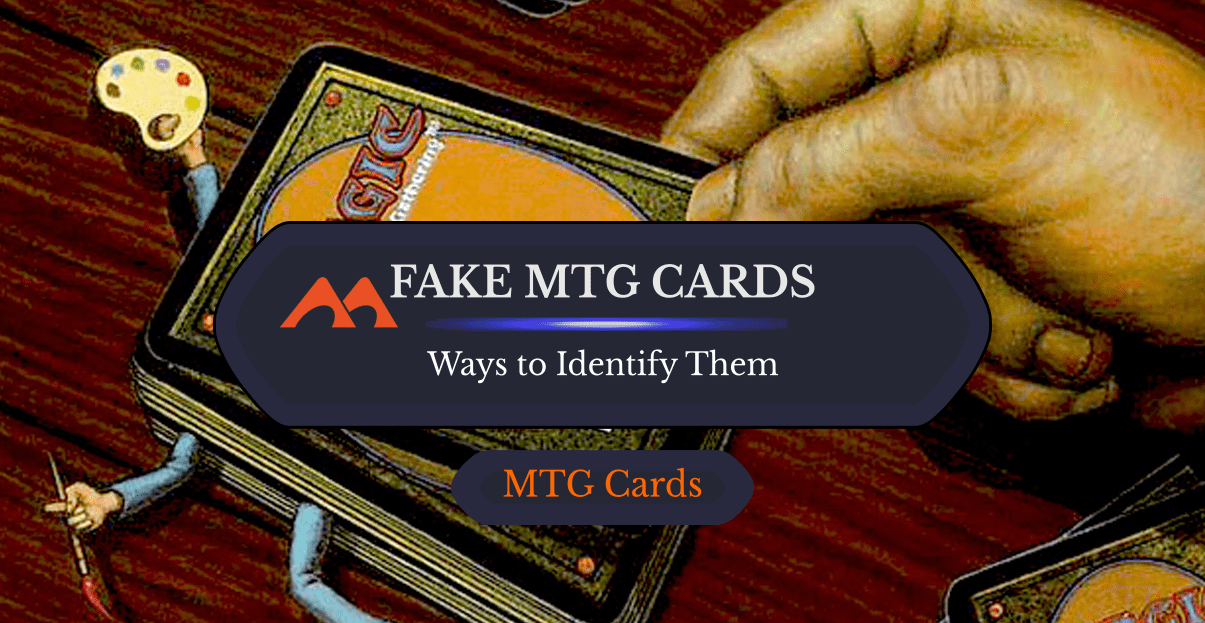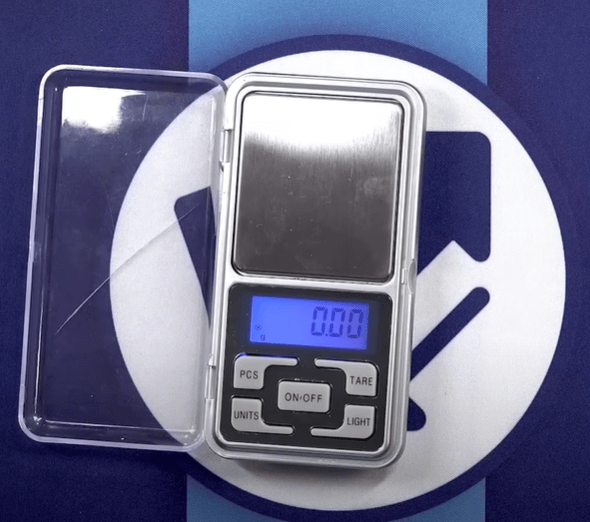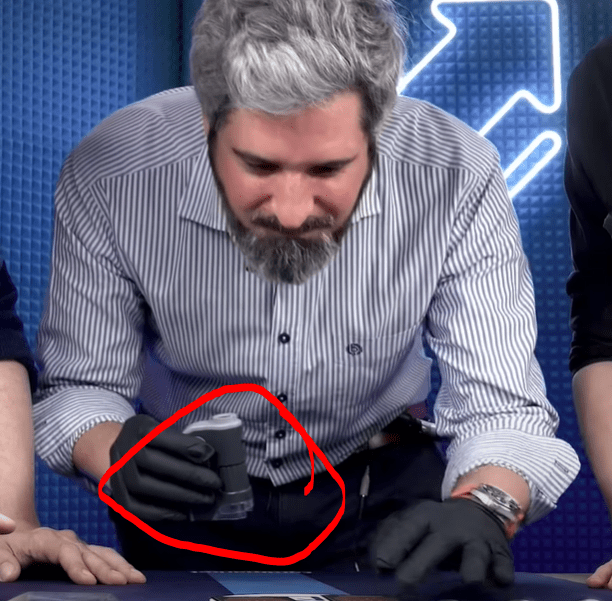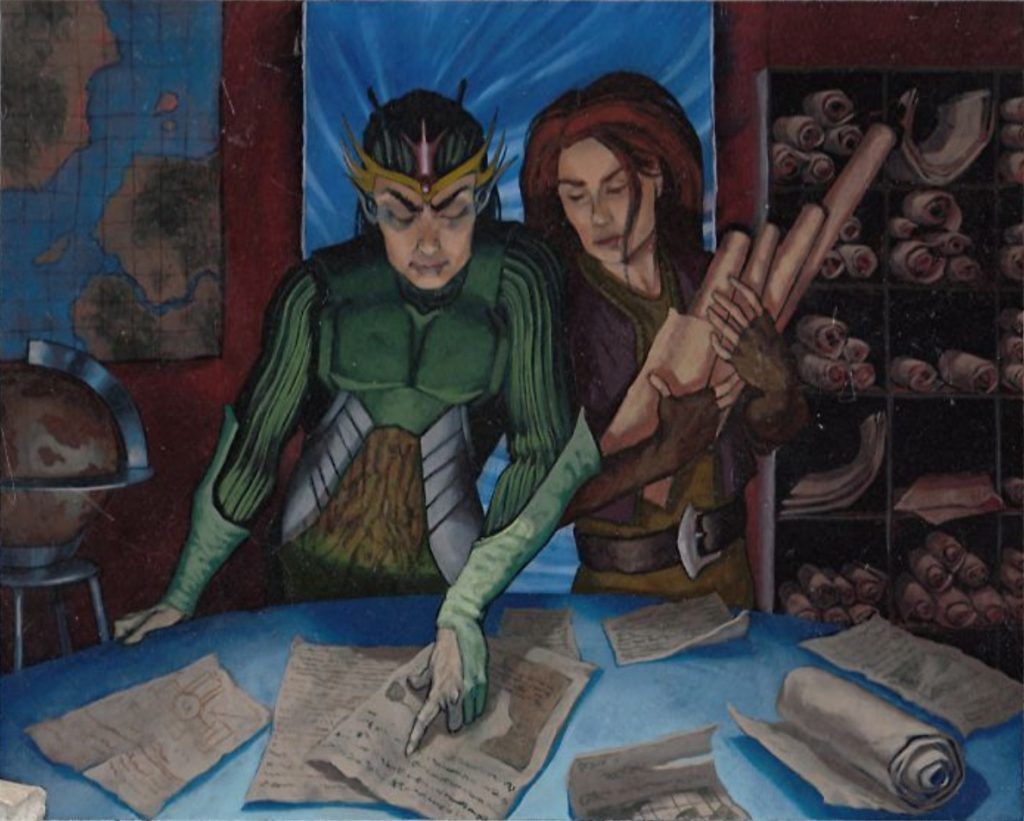Last updated on April 21, 2024

Aesthetic Consultation | Illustration by David Martin
One of the major problems of Magic: The Gathering is the proliferation of counterfeit cards, a longstanding concern in the community, jeopardizing both players and the game's integrity. These fakes aim to deceive players by mimicking sought-after cards, often for financial gain. However, there are ways to prevent you from falling for these scams, so let’s go over a few ways to identify if the cards you may be investing in are fakes or worth your money.
From using tools and gadgets to the “brute force” method, we've got you covered. Let's dive right into it!
Card Ripping

Ruthless Ripper | Illustration by Clint Cearley
This is by far the easiest method to determine if a card is fake, and best of all, the only thing you need is your hands! It consists of taking a card with both hands and ripping it in half. You’ll see that the cardboard should have purple ink across the ripped section, which is slightly blurry. If the card doesn’t have it, it's 100% fake. Still, some proxies may have the ink, despite being fake. The difference is that those present a more solid-looking ink instead of a blurry one.
However, since this is obviously not something you want to do when buying a Power 9. It's a reliable test that can be done on cards that you know are 100% fake.
Card Bending
This test can also minimally damage cards you may own, but another option to ensure a card is fake or not is to bend it over in half without adding too much pressure (like putting it between books). You just need to bend it for a second or two and immediately put it back to its original position. If you spot that the borders of the middle area of the painting are cracked or that it just got pulled up, you’ll know it's a fake card. This happens because usually, the front part of the cards is glued at the top of the proxy, and when they’re bent, the glue fails and the top layer falls. Original Magic cards have the art printed on the front of the cardboard.
Comparison to Authentic Cards
Another quick and efficient way to compare whether a card is authentic is to compare it side by side with one you know isn’t fake. The most obvious fakes have printing and color issues and are fairly easy to spot when compared to the original ones that have crisp and clear printing on them.
Card Texture
WotC uses very particular cardboard to print their cards; in contrast, fake cards tend to use cheaper options, and as such, the texture of the card can feel wildly different. Usually, fake cards, especially foils, can feel very slippery and soft, while regular cards have a texture that’s hard to reproduce by regular means.
Rarity and Edition Markings
Some low-quality fakes do poorly with set symbols, especially in terms of rarity. In some cases, cards have the wrong set number or set symbol, including ones that don’t exist.
Hollow Stamp Reflect
Another way to identify cards is by looking at the hollow stamp. The reflection can be wildly different from an original to a fake one, as the latter is usually just any reflective stamp. However, there are some that look identical to the original ones. Another way to identify it is to feel the reflection. If it's plain, it means that it's likely an original one, as the reflection hollow stamp is printed directly on it. Fake ones, however, have the stamp glued after the card is printed, making it very easy to spot by feel.
Cheap Foil
I already mentioned this, but let's dive deeper. Foils on fake cards are cheap. It's usually a glow on the card, acting as a coat over it, which generally makes it weigh a bit more than a regular foil card. On top of that, the foil feels just like a plastic layer and doesn’t have detail or vary based on the card art.
Light Test
Another test you can run can be done with your phone light. Up until now, you only needed your hands and maybe some original cards for reference, but going forward, you may need some tools to help you in the process.
In this case, you can place the light at the back of your card, and if it's somewhat blurry, you’ll know it's a fake card. Real ones tend to show a clearer showing of where the LED light is behind the card in a clearer tone. Of course, if the cardboard prevents you from seeing the light through the card, it's also a sign the card is fake. This test isn’t 100% foolproof, though, as more versions of foils and variations of cards are printed. There may be some sets where the light test may fail, but there’s less invasive, more reliable ways to find out if cards are authentic.
Card Proportions
Since the process of making proxies is usually done in bulk and not well outlined, fake cards tend to have disproportionate sizes, making them bigger or smaller than their original counterparts. Using a caliper to measure the card's dimensions is a great idea.
Card Weight

Source: https://www.youtube.com/watch?v=0w2QHz88Obo
Speaking of card weight, this is another thing you can check for with a little help from a scale. A regular MTG card tends to weigh between 1.7 to 1.8 grams, while fake ones tend to be heavier as the quality of the cardboard they use is structurally different.
Magnifying Lens Test

Source: https://www.youtube.com/watch?v=0w2QHz88Obo
With the help of a magnifying lens, it's really easy to spot fake cards. Looking into detail, you’ll usually find card printings that are blurry, especially around the edges of the letters or the ones on the backside of the card. On the front, I’ve seen cards that the printing shows patterns on them, like little squares, while the original ones have clear paint on them, and the patterns are missing.
The biggest thing you can spot is on the back of the card, as WotC has been printing cards with the same art file for the backside of them. This file has a particularity, which is that in the green dot at the back, you can find a little bright portion on it. If you zoom a bit more, you’ll be able to see 4 little dots shaping into an L inside the bright portion. If a card doesn’t have this particularity, then it 100% means that it's a fake.
Can You Play with Fake MTG Cards?
At your kitchen table? Yes. However, you won't be able to use fake Magic cards or proxies in competitive events, unless the event says otherwise for price-heavy formats like Vintage, where it's usually allowed to use some proxies to avoid damaging the original cards, as long as you own them. Still, this last part should be up to the discretion of the event organizer, but chances are that this isn’t something you should expect to see in a Pro Tour.
Is It Illegal to Sell Fake MTG Cards?
While it's not illegal to make proxies, selling them is a whole other story, as you’ll likely get hit by copyright laws. This is very different from, let’s say, custom alter cards, as the art on those is the property of the people who make them, and also, you know you aren’t buying a “real card.” I’m not 100% sure how it goes if I print the back of an MTG card and put a custom-altered version on the front, but chances are that its use will be under kitchen table rules. Technically, selling those should be fine as long as it's clear that it’s not an original Magic Card.
Wrap Up

Accumulated Knowledge | Illustration by Randy Gallegos
In Modern times, it becomes harder and harder to spot differences between fake and original cards, so I hope this guide is helpful to you and gives you some guidelines before you can make an investment on some offers that may be too good to be true.
I want to stress to only buy cards from trusted vendors. At worst, you can ask for a reimbursement if you happen to run into an unpleasant surprise.
Thanks so much for reading until now, and as always, if you find this article helpful and want to read more, remember to follow us on X (formerly Twitter) or Facebook, or join the Draftsim Discord, where we post multiple articles daily.
Take care, and see you next time!
Follow Draftsim for awesome articles and set updates:

2 Comments
My biggest issue is that there’s a lot more variation between official products, even within a single set. The three main ones I find are the glossy regular finish, the really papery, and the plasticy feel.
How to spot? Hell I’m intentionally buying them. Making entire decks for $45 with all the fixings
Add Comment